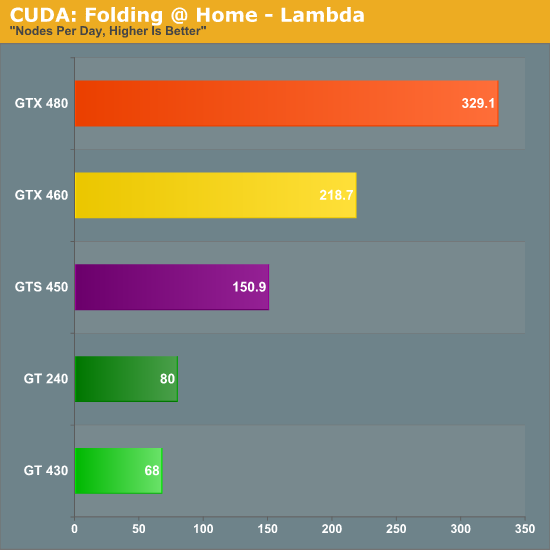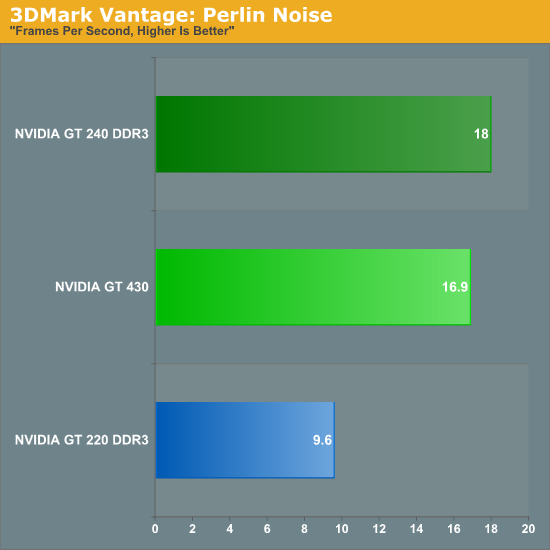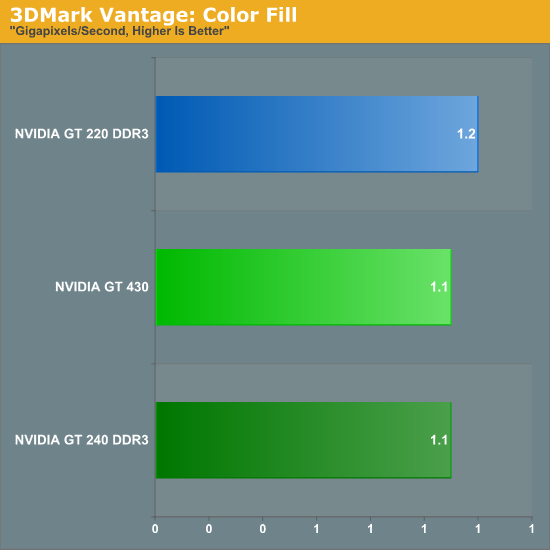NVIDIA's GeForce GT 430: The Next HTPC King?
by Ryan Smith & Ganesh T S on October 11, 2010 9:00 AM ESTCompute Performance & Synthetics
While the GT 430 isn’t meant to be a computing monster and you won’t see NVIDIA presenting it as such, it’s still a member of the Fermi family and possesses the family’s compute capabilities. This includes the Fermi cache structure, along with the 48 CUDA core SM that was introduced with GF104/GTX 460. This also means that it has a greater variation of performance than the past-generation NVIDIA cards; the need to extract ILP means the card performs between a 64 CUDA core card and a 96 CUDA core card depending on the application.
Meanwhile being based on the GF104 SM, the GT 430 is FP64 capable at 1/12th FP32 speeds (~20 GFLOPS FP64), a first for a card of this class.
For our look at compute performance we’ll turn to our trusty benchmark copy of Folding @ Home. We’ve also included the GT 240, a last-generation 96 CUDA core card just like the GT 430. This affords us an interesting opportunity to see the performance of Fermi compared to GT200 with the same number of CUDA cores in play, although GT 430 has a clockspeed advantage here that gives it a higher level of performance in theory.

The results are interesting, but also a bit distressing. GT 430’s performance as compared to the GTS 450’s performance is quite a bit lower, but this is expected. GT 240 however manages to pull ahead by nearly 17%, which is quite likely a manifestation of Fermi’s more variable performance. This makes the GT 220 comparison all the more appropriate, as if Fermi’s CUDA cores are weaker on average then GT 430 can’t hope to keep pace with GT 240.
To take a second look at CUDA core performance, we’ve also busted 3DMark Vantage out of the vault. As we’ve mentioned before we’re not huge fans of synthetic tests like 3DMark since they encourage non-useful driver optimizations for the benchmark instead of real games, but the purely synthetic tests do serve a useful purpose when trying to get to the bottom of certain performance situations.
We’ll start with the Perlin Noise test, which is supposed to be computationally bound, similar to Folding @ Home.

Once more we see the GT 430 come in behind the GT 240, even though the GT 430 has the theoretical advantage due to clockspeed. The loss isn’t nearly as great as it was under Folding @ Home, but this lends more credit to the theory that Fermi shaders are less efficient than GT21x CUDA cores. As a card for development GT 430 still has a number of advantages such as the aforementioned FP64 support and C++ support in CUDA, but if we were trying to use it as a workhorse card it looks like it wouldn’t be able to keep up with GT 240. Based on our gaming results earlier, this would seem to carry over to shader-bound games, too.
Moving on, we also used this opportunity to look at 3DMark Vantage’s color fill test, which is a ROP-bound test. With only 4 ROPs on the GT 430, this is the perfect synthetic test for seeing if having fewer ROPs really is an issue when we’re comparing GT 430 to older cards.

And the final verdict? A not very useful yes and no. GT 220 and GT 240 both have 8 ROPs, with GT 220 having the clockspeed advantage. This is why GT 220 ends up coming out ahead of GT 240 here by less than 100 MPixels/sec. But on the other hand, GT 430 has a clockspeed advantage of its own while possessing half the ROPs. The end result is that GT 430 is effectively tied with these previous-generation cards, which is actually quite a remarkable feat for having half the ROPs.
NVIDIA worked on making the Fermi ROPs more efficient and it has paid off by letting them use 4 ROPs to do what took 8 in the last generation. With this data in hand, NVIDIA’s position that 4 ROPs is enough is much more defensible, as they’re at least delivering last-generation ROP performance on a die not much larger than GT216 (GT 220). This doesn’t provide enough additional data to clarify whether the ROPs alone are the biggest culprit in the GT 430’s poor gaming performance, but it does mean that we can’t rule out less efficient shaders either.
Do note however that while Fermi ROPs are more efficient than GT21x ROPs, it’s only a saving grace when doing comparisons to past-generation architectures. GT 430 still only has ¼ the ROP power as GTS 450, which definitely hurts the card compared to its more expensive sibling.










120 Comments
View All Comments
Mumrik - Monday, October 11, 2010 - link
From the Final Words:"We opened up this article talking about how NVIDIA is FORGING performance in the name of (...)"
Surely you don't mean "forging"...
knutjb - Monday, October 11, 2010 - link
I can see this and similar under performing cards showing up in consumer HTPCs further turning the general public off computer based products giving yet another reprieve to blue ray set top boxes.It seems every time the PC comes closer to taking a key role in the entertainment center a company releases a pos product like this.
manno - Monday, October 11, 2010 - link
I can not agree with your conclusions and I'm an ATI/AMD fan. I will not touch fermi with a 10' pole, but to say from your benchmarks that the 430 is not competitive with the 5570 is just plain wrong. Let's do the numbersBenchmark : AMD 5570 | Nvidia 430
Image Quality : +1 | 0
Crysis : +1 | 0
BattleForge : +1 | 0
HAWX : 0 | +1
Left 4 Dead : 0 | +1
Battlefield: BC2 : +1 | 0
STALKER : 0 | +1
DiRT 2 : +1 | 0
Mass Effect 2 : 0 | +1
Wolfenstein : +1 | 0
On power consumption: I personally feel that a lower idle power consumption is more important than load as my system would sit idle way more frequently that it would be under load, but that depends on the user: Draw or +1 Nvidia
Noise : 0 | +1
Totals:
AMD: 5 | Nvidia: 5
Looks dead even to me both cards would make great HPC cards. I find a lot of image quality dbenchmarks are highly subjective and fail under a double blind test. It's like asking an audiophile for advice on weather you should use MP3's or FLAC's very few people can tell the difference between the two and unless you're highly tuned to it it's not noticable. Not to mention I haven't even gotten to the fact that it's an AMD made denchmark, I wouldn't put any weight in an Nvidia benchmark for an ATI card. I've made 0 purchases based on 3D Mark Vantage scores that handicap Nvidia a rediculous amount due to the GPU compute portion of the benchmark, otherwise I'd own no AMD cards.
PLEASE DEFEND YOUR POSITION.
Full disclosure:
10% of my portfolio is AMD
0.0% of my portfolio is Nvidia
cknobman - Monday, October 11, 2010 - link
Please read the article correctly. It clearly states that it is on par with 5570 but fails every time against the 5670.Given the pricing of this card it is not out of the question to compare it against the 5670 in gaming tests.
This card at its current price point is a huge failure for Nvidia.
The companies banking on 3D tech are going to find hard time in the near future because consumers arent buying in on it. Heck Ive already read about GIGANTIC price cuts in the LCD market coming in the next month because supply is through the roof and no one is buying.
manno - Monday, October 11, 2010 - link
http://www.techeye.net/chips/nvidia-launches-gt-43...http://www.newegg.com/Product/ProductList.aspx?Sub...
looks like their priced evenly...
manno - Monday, October 11, 2010 - link
"GT 430 simply isn’t competitive with AMD’s 5570 and 5670 in gaming performance"Does not read as "on par"
Stuka87 - Monday, October 11, 2010 - link
Well, that would be true if those points were all equal. However they are not. Especially in regards to image quality where the nVidia lost horribly in a test for the market that this card is specifically aimed at.As for gaming, you can pick up 5670's for the same price as the 430, and the 5570 for less. So the 5670 is really the card that nVidia is up against. Which easily beat it in every single performance test.
The lower idle power/temps of the 430 are nice to have, but not if it means significantly worse performance in other areas.
manno - Tuesday, October 12, 2010 - link
You're correct, and I want to nake this clear, my issue isn't with your post it's with this articles conclusion which states:"GT 430 simply isn’t competitive with AMD’s 5570 and 5670 in gaming performance"
in which it states that Nvidia is in an unenviable position HTPC wise because the 5570 is superior to the 430. Which is not true based on their own benchmarks. Of course the 5670 is better but that's not the card this Nvidia is positioning against it that will be the GT 440 or maybe 435's job.
The 5770 and 430 are the exact same card benchmark and price wise:
http://www.techeye.net/chips/nvidia-launches-gt-43...
http://www.newegg.com/Product/ProductList.aspx?Sub...
As for AMD's Image Quality test, that is not the best test/benchmark they had at their disposal. A double blind comparison where you play two clips one after the other to random people and give them an similar, better, worse question is the best test for something as subjective as image quality. Using an AMD test to judge any card is inherently biased in AMD's favor. Their conclusion is wrong.
esc923 - Monday, October 11, 2010 - link
Lol. You seem to think highly of yourselves asking others to defend their position when you can't even defend your own.You've thrown a lot of opinions (e.g. "I personally feel..." or "I find..."). All I can say is let's ignore your personal feelings as they're irelevant, ok?
That just leaves your basic reasoning, and you've failed even more miserably here. Weighing the performance of something like "Battlefield 2" equally to that of video "image quality" to get your conclusion (i.e. "looks dead even to me") is just plain idiotic considering we're talking about the HTPC market where image quality is more imporant than video game frame rates. Which is pretty frigging obvious.... Note that I'm not calling you idiotic, just your reasoning.
You see a lot of crap on the internet that you ignore, but the thing is, your memo was written in such a serious way that even includes a disclaimer as well as a DEMAND in caps that you've just got to laugh because the end result comes across as someone trying too hard to look smart, and failing.
manno - Monday, October 11, 2010 - link
From my previous post:http://www.techeye.net/chips/nvidia-launches-gt-43...
http://www.newegg.com/Product/ProductList.aspx?Sub...
The 5570 and the 430 are priced exactly the same their performance for all intents and purposes is exactly the same. ATI and Nvidia are both taking the same position in this category, why is ATI's position superior? Because an Nvidia card doesn't perform as well as an ATI card on an ATI created benchmark. That is a poor reason to state one card is superior to another.
As I stated previously a metric like image quality is purely subjective unlike a FPS score which is objective. What looks like garbage to one person looks great to another.
Regarding my intelligence, my argument is correct regardless of how smart I am. Furthermore I could care less how smart anyone here thinks I am, for all I care your can hold a mental image of me squatting in mud smiling as I shove berries up my nose.